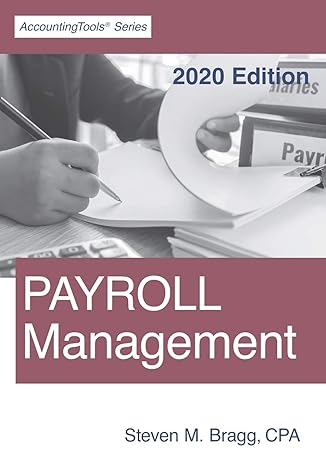Question
1. THE FOLLOWING INFORMATION IS USED FOR QUESTIONS 1 9. Test Company projected the following unit sales for the next five quarters. Unit sales Year
1.
THE FOLLOWING INFORMATION IS USED FOR QUESTIONS 1 9.
Test Company projected the following unit sales for the next five quarters.
|
| Unit sales |
| Year 1, Quarter 1 | 1,000 |
| Year 1, Quarter 2 | 1,200 |
| Year 1, Quarter 3 | 1,500 |
| Year 1, Quarter 4 | 2,000 |
| Year 2, Quarter 1 | 1,000 |
All units sell for $10 per unit.
Test Company had 180 units in finished goods inventory on January 1, Year 1. The companys policy is to have 20% of the following quarters projected sales in ending finished goods inventory.
Each unit required 5 lbs. of direct materials. Projected direct materials cost is $0.20 per lb. The companys policy is to have 10% of the following quarters production needs in ending raw materials inventory. The company had 390 pounds of raw materials in inventory on January 1, Year 1 and expects to have 530 lbs. of raw materials in inventory on December 31, Year 1.
Each unit requires 0.12 direct labor hours. The direct labor wage rate is projected to be $10 per hour.
Overhead is applied on the basis of direct labor hours. The variable overhead rate is $5 per direct labor hour. Fixed overhead is expected to be $1,645 per quarter.
Determine projected sales revenue for Year 1.
Note: Give your answer using dollar signs and commas but no decimal points (cents).
Example: $12,345
2.
Determine the desired ending finished goods inventory for Year 1.
Note: Give your answer using commas but no decimal points. Do not include the word units.
Example: 12,345
3.
Determine the total number of units to be produced in Year 1, Quarter 3.
Note: Give your answer using commas but no decimal points. Do not include the word units.
Example: 12,345
4.
Determine the desired ending raw materials inventory (in lbs.) in Year 1, Quarter 2.
Note: Give your answer using commas but no decimal points. Do not include the word lbs.
Example: 12,345
5.
Determine the quantity of raw materials to be purchased (in lbs.) in Year 1, Quarter 4.
Note: Give your answer using commas but no decimal points. Do not include the word lbs.
Example: 12,345
6.
Determine the total cost of direct materials to be purchased in Year 1.
Note: Give your answer using dollar signs and commas but no decimal points (cents).
Example: $12,345
7.
Determine the total direct labor hours needed in Year 1, Quarter 4.
Note: Give your answer using commas but no decimal points. Do not include the word lbs.
Example: 12,345
8.
Determine the projected direct labor cost in Year 1, Quarter 3.
Note: Give your answer using dollar signs and commas but no decimal points (cents).
Example: $12,345
9.
Determine the projected total overhead cost for Year 1.
Note: Give your answer using dollar signs and commas but no decimal points (cents).
Example: $12,345
10.
Test Company projected the following sales for the first six months of the year.
|
| Total sales |
| January | $250,000 |
| February | 300,000 |
| March | 280,000 |
| April | 310,000 |
| May | 320,000 |
| June | 300,000 |
Of the total sales, 10% are cash sales, and the remaining sales are on credit. Credit sales are collected: 30% in the month of sale, 50% in the first month following the sale, 15% in the second month following the sale, and the remaining credit sales are uncollectible.
Determine total cash collections for April.
Note: Give your answer using dollar signs and commas but no decimal points (cents).
Example: $12,345
11.
Test Company purchases all materials on account. The company pays for 60% of materials purchases in the month of the purchase and 40% in the month following the month of purchase. Budgeted purchase for the first six months of the year are as follow.
|
| Purchases |
| January | $100,000 |
| February | 120,000 |
| March | 125,000 |
| April | 115,000 |
| May | 100,000 |
| June | 110,000 |
Determine the cash payment April for materials purchases.
Note: Give your answer using dollar signs and commas but no decimal points (cents).
Example: $12,345
Step by Step Solution
There are 3 Steps involved in it
Step: 1

Get Instant Access to Expert-Tailored Solutions
See step-by-step solutions with expert insights and AI powered tools for academic success
Step: 2

Step: 3

Ace Your Homework with AI
Get the answers you need in no time with our AI-driven, step-by-step assistance
Get Started


